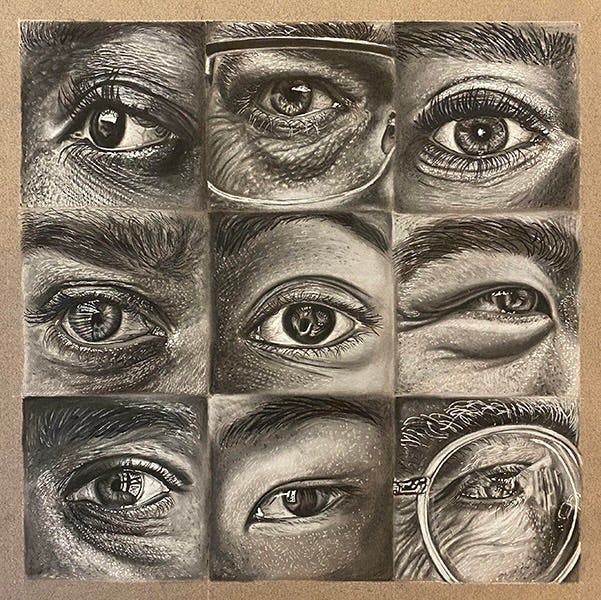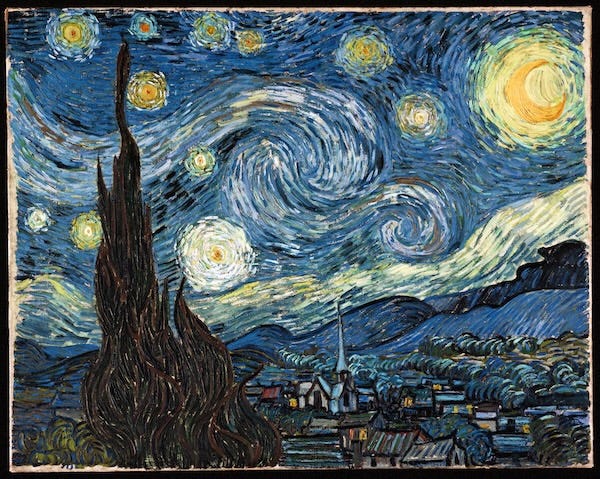We benefit from learning more about the wonders of the human body. Wellness always begins with our lifestyles: what we eat, how we move, and how we navigate the complexities of modern living. Aging is part of our lifespan - there is only one escape! I became curious about what happens to our bodies as we age and what strategies we can employ, given our access to wisdom, common sense, technology, and scientific information. Each month, I will feature an article on the aging human body. I am not a medical professional, and that’s a good thing because I write so my readers can easily understand.
My Constant Companion
I have worn glasses since 7th grade, when I discovered that my focus on things far away was blurry. My vision has slowly deteriorated over my life, requiring more powerful lenses every few years. In my forties, I began wearing progressive lenses, which incorporate a lens to correct the blurriness I was experiencing when reading. My glasses are my constant companion: they are the first thing I reach for when I wake and the last thing I remove when I go to sleep. Once, while on a trip, my purse, which held my glasses, was stolen, and I had to squint my way home. I now carry a second set of glasses in my luggage. The only activities I can do without glasses are walking, exercising, eating, and talking.

For many middle-aged people, changes in their eyesight are the first indications of aging. Our increasing incapacity to focus on close objects, called presbyopia, causes behaviors like moving a dinner menu closer or farther away, excessive squinting, and frustration at our inability to read small print, thread a needle, or connect a screwdriver to a screw. Presbyopia occurs when the lens of the eye becomes so stiff that it can no longer be flexed into position to see up close. This is a recurrent theme as we age: many parts of our bodies lose their flexibility either through the process of hardening or degeneration. Two other common changes with our older eyes are a reduced ability to distinguish similar colors like blue and black and a slower ability to adjust to changing levels of light.
Unless corrective lenses are worn, most people tend not to think about their eye health and are not likely to have regular eye exams. According to a poll by the American Academy of Ophthalmology, nearly two-thirds of Americans report having eye or vision problems, but only 13 percent of Americans have an eye exam when experiencing problems with their vision. Yet, many of the eye diseases associated with aging do not present symptoms in the early stages, and by the time symptoms are noticeable, the disease could be well advanced.
When was your last eye exam?
As we age, our eyes are susceptible to various deteriorating conditions that can result in vision loss. We should have eye exams every other year from age 18 to 60 and every year if we are over 60. Everyone aged 40 and older should have regular comprehensive dilated eye examinations. Those with risk factors like diabetes, high blood pressure, a family history of eye diseases, or who take pharmaceutical drugs that have vision-related side effects may need more frequent exams.
With the growing number of older adults in the United States, eye disease and vision loss are becoming public health concerns. Age-related eye conditions include macular degeneration, cataracts, glaucoma, and diabetic eye diseases. Since many eye diseases often have no early symptoms, early detection and treatment are critical to preventing vision loss in your elder years.
Dry Eye
Our eyes regularly produce tears to keep our eyes moist. As we age, hormonal changes in both men and women can reduce the amount of tears, resulting in a condition called dry eye. The condition is more common among postmenopausal women. Specific diseases, health conditions, medications, excess computer time, and refractive eye surgery can also cause dry eye. Ironically, dry eye often produces an abundance of tears to offset the symptoms, which include:
Stinging or burning
Gritty feeling
Red or irritated
Sensitivity to wind or cigarette smoke
Contact lenses feel painful
Blurry vision when reading
Treatment includes using prescribed or OTC artificial tears or ointments and applying warm compresses on the eyes. In severe cases, surgery can be done to temporarily block tear ducts.
Cataracts
The leading cause of vision loss in the world, cataracts affect 25 million Americans and are expected to double to 50 million by 2050. Cataracts primarily affect white women, and by age 75, more than half of all Americans will have cataracts. Cataracts are a clouding of the eye’s lens and form due to proteins that begin to clump together. They grow slowly and eventually will produce symptoms that include:
Cloudy or blurry vision
Colors appear faded
Sensitivity to glare; headlights, lamps, or sunlight may appear too bright; a halo may appear around lights
Poor night vision
Double vision or multiple images in one eye (this symptom may clear as the cataract gets larger)
Frequent prescription changes in your eyeglasses or contact lenses
Treatment consists of surgery that removes the cloudy lens and replaces it with an artificial lens.
Risk factors include advancing age, diabetes, smoking, exposure to sunlight, excessive use of alcohol, poor nutrition, and chronic stress. Untreated cataracts can result in blindness.

Glaucoma
Defined as a group of diseases that eventually damage the optic nerve, causing vision loss and blindness, glaucoma is detected by the slowly increasing buildup of pressure in the eyeball. High blood sugar and insulin levels can narrow the eyes' blood vessels, increasing pressure. In the early stages, there are no symptoms, so a comprehensive dilated eye exam is necessary for diagnosis. In fact, in 90% of glaucoma cases, there are no early symptoms until permanent damage has occurred. African Americans over the age of 40, everyone over 60 (especially Mexican Americans), and anyone with a family history of glaucoma is at higher risk. Glaucoma cannot be cured, and lost vision cannot be restored, though there are medical treatments that can slow the disease’s progression.

Age-Related Macular Degeneration (AMD)
A disease of the retina, AMD is caused by the slow deterioration of the macula and is a leading cause of vision loss in people over age 50. It affects the central vision (causing blurriness and darkness) that is needed to see objects clearly and can impact the ability to do common things like drive, read, and recognize faces. I witnessed this devastating vision loss when I walked an 80-year-old acquaintance with AMD to a viewpoint of an expansive view of a beautiful river canyon, and he asked what he was looking at.
Four risk factors cannot be changed: advanced age, race (Caucasians have higher rates), genetic predisposition, and family history. Research indicates that lifestyle factors, with specific attention to diet, may help prevent and slow the progression of AMD, but there is no cure.

“My vision had always been very sharp — both near and far. When my eyesight was particularly good, I could read very fine print and count the trees on the mountains miles away. When my eyes began to not see sharply as they had for 80 years and the world began to turn grey, I was bothered and gradually stopped working. In time, I was surprised that this world could sometimes be beautiful in a new way, and began to think — how could I start again and begin to paint this new world.
Georgia O’Keeffe, 1970s
Lifestyle
Research indicates that lifestyle choices are significant factors in preventing age-related eye diseases.
Eat a healthy diet that includes fruits and vegetables, especially dark leafy greens. Many fruits and vegetables that are yellow and orange contain high levels of beta-carotene and other carotenoids, which are converted into Vitamin A.
Lutein is a powerful antioxidant that helps protect the eyes from oxidative stress triggered by exposure to sunlight and digital devices. For prevention, increase dietary sources of lutein and help its bioavailability by cooking it in fat. Excellent sources of lutein include leafy greens, asparagus, green beans, and eggs. Dark blue and red fruits, especially berries, are rich in lutein and anthocyanosides.
Eat wild-caught cold-water fish like salmon, trout, and mackerel to add or increase your omega-3 fatty acid intake. Plant sources of omega-3 fatty acids include flaxseeds and walnuts.
Maintain a healthy weight. Obesity is linked to diabetes, which is a contributing factor in age-related eye diseases and increases the risk levels for those with other risk factors. Diabetes can cause additional eye diseases not discussed here.
Avoid nicotine and excessive alcohol.
Wear UV-protectant sunglasses to safeguard your eyes.
Spending many hours each day staring at screens can cause Computer Vision Syndrome (also called Digital Eye Strain), which creates eye strain that contributes to deteriorating eyesight. Follow the 20/20/20 rule: take a 20-second break to view something 20 feet away every 20 minutes. The most important preventative strategy is to monitor eye health through regular comprehensive dilated eye exams.
Herbs
Since oxidative stress and inflammation can contribute to the development of age-related eye diseases, the use of herbs that have antioxidant and anti-inflammatory properties may benefit overall eye health.
Ginkgo Standardized Extract (Ginkgo biloba): Ginkgo increases blood flow to the brain, especially to the tiny capillaries, scavenges free radicals, and preliminary research suggests that it could be used for both prevention of and therapeutically for eye diseases.
Hawthorn (Crataegus spp.): Hawthorn supports the cardiovascular system overall and strengthens capillaries, which benefits eye health. It can be taken as capsules, tea, or extract.
Green Tea (Camellia sinensis): Catechin, an antioxidant found in green tea, reduces oxidative stress that can be associated with some eye diseases.
Bilberry (Vaccinium myrtillus): The European cousin of the American blueberry, bilberry has a long history of use for eye health. (During World War II, British Air Force pilots were given bilberry to improve their night vision.) The late Dr. James Duke, who had a family history of eye diseases, was a strong proponent of using anthocyanosides-rich bilberry fruit for both the prevention and treatment of eye diseases.
Resources
https://www.nia.nih.gov/health/vision-and-vision-loss/aging-and-your-eyes
https://www.nei.nih.gov/learn-about-eye-health/outreach-resources/vision-and-aging-resources





Excellent article, it's vital to look after our eyes and get regular checks. I've had cataract surgery on both eyes.
If it were not for cataract removal surgery, I'd be completely blind. We're lucky (medically) to live in these times, compared to only a few decades ago.